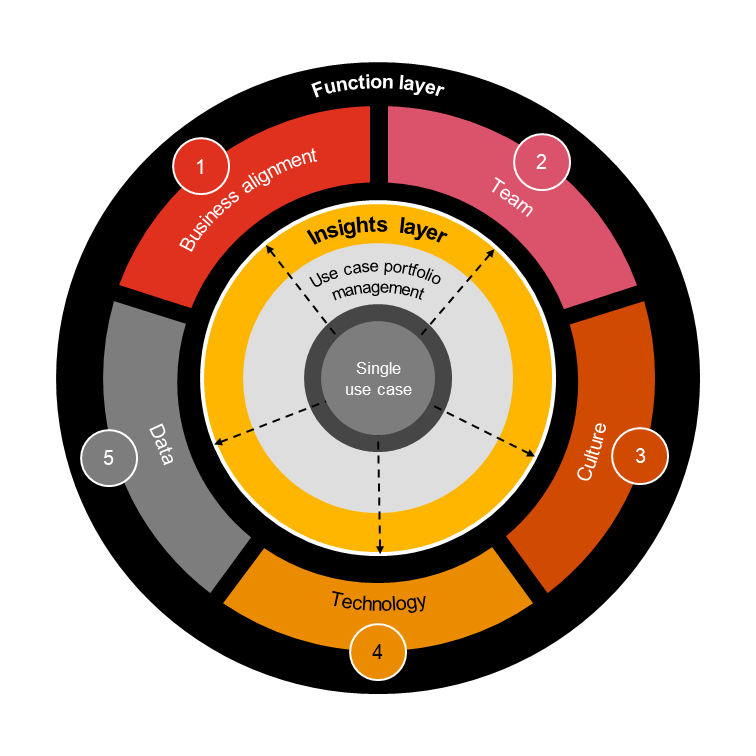Some organisations lack the necessary capabilities – the ‘functional layer’ as we describe it in our value-driving framework, ‘Creating more value with your people analytics efforts’. Even if the foundational capabilities are in place, many still find it difficult to connect with business teams, understand what questions they want people analytics to address and develop the use cases to deliver – the ‘insight layer’ in our value framework. Ultimately, the two layers are inexorably linked. The more business insight and strategic value people analytics can generate, the more the business will engage with it and invest in the capabilities.
Our framework for effective people analytics

Webcast with leaders and professionals in the area of people analytics
In a recent PwC-hosted webcast people analytics leaders and practitioners shared their perspectives on how to develop strategic insights and win the business buy-in you need to deliver real value.
The panel brought together Ralf Buechsenschuss, Employee Experience Executive at Microsoft, Andreas Maroulis, Global Manager HR Analytics at Just Eat Takeaway and Dr Dieter Veldsman, Chief Scientist: HR and Organizational Development at the Academy to Innovate HR (AIHR).
The three panellists know that people analytics can give businesses a powerful edge in a fast-evolving business environment. Andreas Maroulis: “To have confidence in the way forward, we should try to make sure that every decision is backed by data”. Ralf Buechsenschuss believes that “we should apply the same evidence-based rigour to how we invest in employees as we would for financial decisions”.
But progress in securing the necessary understanding and trust within the business and boardroom is mixed. “Companies that are lagging behind are missing an opportunity to influence the business on what the next steps should be,” says Dieter Veldsman.
That’s why it’s so critical to work with management boards and business teams to understand the pressing issues they face and then focus people analytics on these priorities. Maroulis: “We are not doing people analytics for HR. Everything we work on should have a business angle and benefits”.
Understanding what the business really wants
The practical challenge is determining what is most useful to the business. As the panellists highlight, dashboards and management packs are great at tracking movements over time. But unless they’re immediately relevant, they won’t be read.
Even focusing on a particular issue such as employee experience may miss the mark as there are likely to be multiple stakeholders involved – including employees, line and senior managers – each with a different and even conflicting perspective.
For our panellists, this underlines the importance of cutting through to what the business really wants. “There will always be conflicts, that’s the nature of the work,” says Veldsman. “That’s why we need to bring it back to what’s the question that needs to be answered and what is the problem we’re trying to solve. When that’s clear, you can then rally the business around a common cause, which is not a people analytics cause but a business-impact cause.”

Equipped to deliver
From a functional perspective, the big question is how to create the capabilities and underlying operating model to deliver the insights. According to Maroulis the vital importance of breaking down silos and being in tighter alignment with the business. Where people analytics sits within the organisation has evolved at Just Eat Takeaway, starting within the Data & Analytics department, later within the HR function to be closer to direct stakeholders. But the central priority has remained the same. “We are always looking for enabling conditions, whether it's in our ways of working or organizational structure, to optimise our operating model and ensure that those silos don't exist. And that boils down to what our service delivery model is” he says.
Technology is clearly an important part of the operating model, but it’s only a means to an end. The panellists agree on the need for a guiding vision on what the technology is there to do and how it will be used. As Buechsenschuss warns, the risk is having so many tools that operations become needlessly complex and confusing. “Okay, we want to switch on this shiny new HR tool, but let’s first define what we are switching on and the different journeys employees will follow when using the tool,” he says. Veldsman corroborates the danger of hasty technology decisions because "a shortcut today, becomes practice tomorrow and a problem in the long term".
Getting stakeholders on board
Next to the well-organized operating model, another big priority is stakeholder buy-in. Veldsman believes that people analytics should do a better job at telling a story and connecting the dots for people. "Very often, even though we bring relevant insights and information, stakeholders don't see where it fits given where business is at the moment. That's why the storytelling component and how you bring insights to the table is so important for the future of people analytics".
Contextualising and connecting the dots is equally important with other stakeholders as well. For example, one way to improve data quality is by motivating data creators with an appealing storyline. To win them around, Buechsenschuss recommends a quid pro quo of data supplied and personalised analytics as the reward. “A win-win currency of data. Looking at skills, you could say to employees ‘if you tell me the skills you have, then I can predict which career paths you can follow and what training would enable you to realise your potential’”.
Start small, aim high
While developing and embedding people analytics takes time, it’s clear from our panel that it’s already delivering value and the hurdles ahead can be overcome. When asked for their top tips and takeaways, the answers are revealing, with “show don’t tell” as the binding theme:
Veldsman: “Listen more than speak, tell visual stories, remain curious and take small steps for long-term impact.”
Maroulis: “Come with suggestions and solutions, rather than just problems.”
Buechsenschuss: “Think about internal customers and the problems they have. Think about how skills and capabilities need to evolve to meet these demands.”
If you want to find out more about how to power up your people analytics, watch our Success strategies to power up your people analytics webcast. For a comprehensive guide, download our Creating more value with your people analytics efforts framework.
Five steps to make the value of people analytics visible
Contact us




















